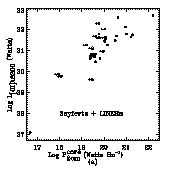
Radio Sources in Low-Luminosity Active Galactic Nuclei.
I.
VLA Detections of Compact, Flat-Spectrum Cores
Neil M. Nagar1, Heino Falcke2, Andrew S. Wilson1,3, Luis C. Ho4
1Astronomy Department, University of Maryland, College Park, MD 20742-2421 (neil,wilson@astro.umd.edu)2 Max-Planck-Institut für Radioastronomie, Auf dem Hügel 69, 53121 Bonn, Germany (hfalcke@mpifr-bonn.mpg.de)
3Adjunct Astronomer, Space Telescope Science Institute
4Observatories of the Carnegie Institution of Washington, 813 Santa Barbara St., Pasadena, CA 91101 (lho@ociw.edu)
The Astrophysical Journal, Vol. 542, p. 186
Abstract:
We report a high resolution (0.2"), 15 GHz survey of a sample of 48 low-luminosity active galactic nuclei with the Very Large Array. Compact radio emission has been detected above a flux density of 1.1 mJy in 57% (17 of 30) of low-ionization nuclear emission-line region (LINER) nuclei and low-luminosity Seyferts. The 2 cm radio power is significantly correlated with the emission-line ([O I] lambda 6300) luminosity for all objects in the sample. Using radio fluxes at other frequencies from the literature, we find that at least 15 of the 18 detected radio cores have a flat to inverted spectrum (alpha >= -0.3, Snu proportional to nualpha). The presence of a compact, flat-spectrum radio core is consistent with current ideas involving accretion onto massive black holes in low-luminosity active galactic nuclei such as jet and advection-dominated accretion flows. While the present observations are consistent with the radio emission originating in star formation regions (the brightness temperatures are >= 102.5-4.5 K for objects in the sample), higher resolution radio observations of 10 of the detected sources, reported in an accompanying paper, show that the cores are very compact (<~ pc), of high brightness temperature (Tb >~ 108 K) and probably synchrotron self-absorbed, ruling out a starburst origin. Thus, our results suggest that at least 50% of low-luminosity Seyferts and LINERs in the sample are accretion powered. We have detected only 1 of 18 ``transition'' (i.e. LINER + H II) nuclei observed, so either their radio cores are significantly weaker than those of ``pure'' LINERs, or their central engines are intrinsically different from those of ``pure'' LINERs.
Compact 2 cm radio cores are found in both type 1 (i.e. with broad Halpha) and type 2 (without broad Halpha) nuclei. There is weak evidence, limited in significance by small numbers, that low-luminosity active galactic nuclei with compact radio cores exhibit radio ejecta preferentially aligned along the rotation axis of the galaxy disk. If this result is confirmed by a larger sample, it would lend support to the idea that the misalignment of accretion disks with the galaxy stellar disk in more luminous Seyfert galaxies is a result of radiation pressure induced warping of their accretion disks. There is some support for a scenario in which most nuclei which exhibit a 2 cm compact core also have an unresolved nuclear UV source. Unresolved UV sources in nuclei with 2 cm compact cores are more prone to host galaxy obscuration than those in nuclei undetected at 2 cm.
Paper: Available in full length as PostScript and LaTex (AAS LaTex) Format.
Other publications can be found here.
Questions: Heino Falcke, hfalcke@mpifr-bonn.mpg.de